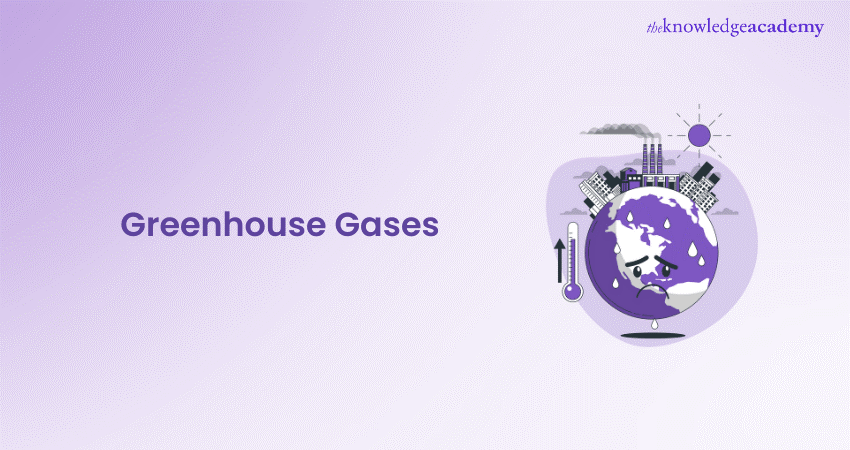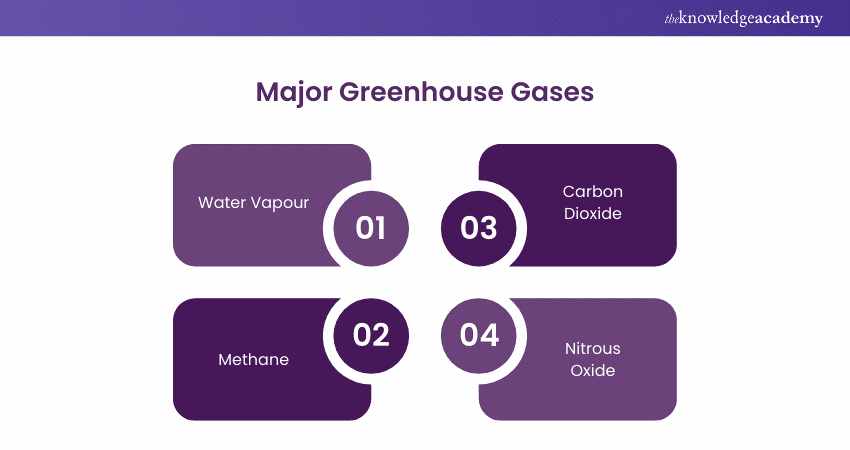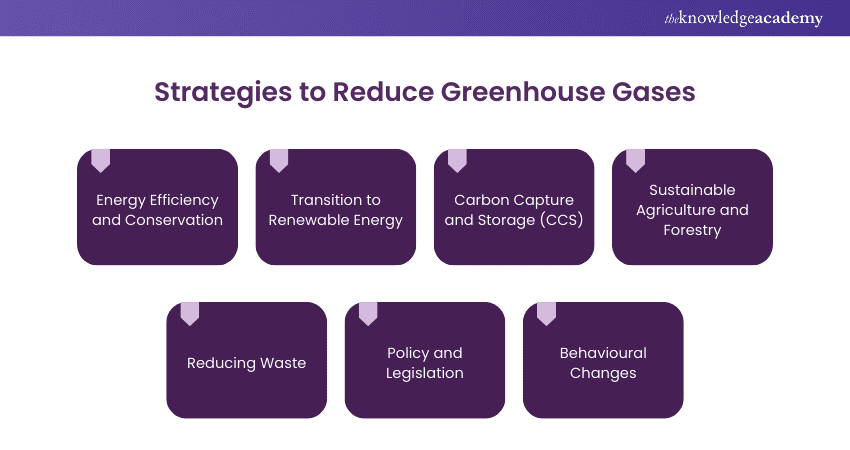We may not have the course you’re looking for. If you enquire or give us a call on +44 1344 203999 and speak to our training experts, we may still be able to help with your training requirements.
Training Outcomes Within Your Budget!
We ensure quality, budget-alignment, and timely delivery by our expert instructors.

Have you ever wondered what keeps our planet comfortably warm, allowing life to flourish? The secret lies in a group of atmospheric gases known as Greenhouse Gases (GHGs). These invisible protectors form a thermal blanket around Earth, trapping just the right amount of heat to sustain life. But there's a twist: the gases nurturing our existence are now driving the global crisis of climate change.
Are we doing enough to combat the rise in Greenhouse Gases? As we delve into this blog, we'll explore the major types of Greenhouse Gases, their sources, and their profound environmental effects. We'll explore strategies to reduce emissions and emphasise the importance of collective action to protect our future generations.
Table of Contents
1) What are Greenhouse Gases?
2) Major Greenhouse Gases
a) Water Vapour
b) Carbon Dioxide
c) Methane
d) Nitrous Oxide
3) How to Reduce Greenhouse Gases?
4) Conclusion
What are Greenhouse Gases?
Greenhouse Gases are components of the atmosphere that trap heat, keeping the Earth's surface warmer than it would be if these gases were not present. This natural phenomenon is known as the Greenhouse Effect. Without Greenhouse Gases, the Earth's average temperature would become extremely cold, making it difficult for life to thrive.
The primary Greenhouse Gases in Earth's atmosphere include water vapour, Carbon Dioxide (CO2), Methane (CH4), Nitrous Oxide (N2O), and Ozone (O3). These gases absorb Earth's infrared radiation and re-radiate it, warming the planet by directing heat back to the surface.
Major Greenhouse Gases
Understanding the key players in the Greenhouse Effect is essential to grasping how our climate is changing. Here are the major Greenhouse Gases driving this global phenomenon.

1) Water Vapour
Water vapor is the most prevalent greenhouse gas in Earth’s atmosphere. Its concentration is primarily regulated by natural processes such as evaporation and condensation. It plays a crucial role in the naturally occurring greenhouse effect.
a) Source: Evaporation from oceans, lakes, and rivers, and transpiration from plants.
b) Effect: Water vapor enhances the warming effect of other greenhouse gases. As atmospheric temperatures rise, the air holds more water vapor, creating a feedback loop that intensifies warming.
2) Carbon Dioxide
Carbon dioxide, a significant greenhouse gas, is mainly produced by human activities. It is the second most common greenhouse gas in the atmosphere after water vapor.
a) Source: Burning of fossil fuels (coal, oil, natural gas), deforestation, industrial processes, and respiration.
b) Effect: CO2 is a major contributor to the anthropogenic (human-caused) greenhouse effect. It has a long atmospheric lifetime, meaning its impact on climate can last for centuries.
3) Methane
Methane, though present in smaller quantities than carbon dioxide, is a highly potent greenhouse gas. It has a much higher Global Warming Potential (GWP) over a shorter period.
a) Source: Agriculture (especially from livestock digestion and rice paddies), landfill emissions, natural gas and oil extraction, and wetlands.
b) Effect: Methane is more effective than CO2 at trapping heat in the atmosphere over a 20-year period. Its GWP is about 25 times that of CO2 over 100 years.
4) Nitrous Oxide
Nitrous oxide, also known as laughing gas, is another powerful greenhouse gas with a significant impact on global temperatures and climate change.
a) Source: Agricultural activities (particularly the use of synthetic and organic fertilizers), industrial processes, combustion of fossil fuels, and biomass burning.
b) Effect: N2O has a GWP approximately 298 times that of CO2 over a 100-year period. It also contributes to the depletion of the ozone layer.
Start your ISO 14001 Foundation Certification Training today and enhance your Environmental Management skills!
How to Reduce Greenhouse Gases?
Here are several strategies that can be employed:

1) Energy Efficiency and Conservation
Reducing CO2 emissions in buildings, houses, and industries can be done by improving energy efficiency. Better insulation, energy-efficient lighting and appliances, as well as encouraging energy-saving habits, can all help achieve this.
2) Transition to Renewable Energy
Replace fossil fuels with renewable energy sources, such as geothermal, hydro, solar, and wind, to significantly reduce CO2 emissions. For this change to occur, infrastructural and technological investments in renewable energy are needed.
3) Carbon Capture and Storage (CCS)
Carbon collection and storage technology can collect up to 90% of CO2 emissions generated by the use of fossil fuels. This prevents CO2 from entering the atmosphere.
4) Sustainable Agriculture and Forestry
Employing environmentally friendly farming techniques, such as precision farming, agroforestry, and improved livestock management, can reduce methane and nitrous oxide emissions. Reforestation and afforestation efforts can absorb CO2 from the atmosphere, acting as carbon sinks.
5) Reducing Waste
Employing waste reduction strategies, such as recycling, composting, and reducing food waste, can lower methane emissions from landfills. Proper waste management practices are essential in reducing GHG emissions.
6) Policy and Legislation
Governments play an important role in regulating and incentivising reductions in greenhouse gas emissions. Carbon pricing, trading of emissions plans, and renewable energy project subsidies have the potential to cause considerable change.
7) Behavioural Changes
Individual actions, such as using public transportation, reducing meat consumption, and adopting a more sustainable lifestyle, can significantly reduce greenhouse gas emissions.
Transform with ISO 14097 - start your ISO 14097 Greenhouse Gas Management Training - sign up now!
Conclusion
Understanding Greenhouse Gases is key to tackling climate change. By uncovering their roles and impacts and taking bold steps to reduce emissions, we can collectively fight the global climate crisis. Let's unite in this mission for a sustainable future, making every effort count towards saving our planet.
Master Environmental Management with expert ISO 14097 Training – join now!
Frequently Asked Questions

The most affected greenhouse gas by human activities is carbon dioxide. Its levels have significantly increased due to burning fossil fuels, deforestation, and industrial processes that drive climate change.

Yes, Greenhouse Gases affect climate change by trapping heat in the Earth's atmosphere. This causes the Greenhouse Effect, altering weather patterns, increasing global temperatures, and contributing significantly to climate change.

The Knowledge Academy takes global learning to new heights, offering over 30,000 online courses across 490+ locations in 220 countries. This expansive reach ensures accessibility and convenience for learners worldwide.
Alongside our diverse Online Course Catalogue, encompassing 17 major categories, we go the extra mile by providing a plethora of free educational Online Resources like News updates, Blogs, videos, webinars, and interview questions. Tailoring learning experiences further, professionals can maximise value with customisable Course Bundles of TKA.

The Knowledge Academy’s Knowledge Pass, a prepaid voucher, adds another layer of flexibility, allowing course bookings over a 12-month period. Join us on a journey where education knows no bounds.

The Knowledge Academy offers various ISO 14097 Training, including ISO 14097 Greenhouse Gas Management Training. This course caters to different skill levels, providing comprehensive insights into Environmental Aspects and Impacts Register.
Our Health & Safety Blogs cover a range of topics related to Greenhouse Effect, offering valuable resources, best practices, and industry insights. Whether you are a beginner or looking to advance your Health and Safety skills, The Knowledge Academy's diverse courses and informative blogs have got you covered.
Upcoming Health & Safety Resources Batches & Dates
Date
 ISO 14097 Greenhouse Gas Management Training
ISO 14097 Greenhouse Gas Management Training
Thu 1st Jan 1970







 Top Rated Course
Top Rated Course



 If you wish to make any changes to your course, please
If you wish to make any changes to your course, please


